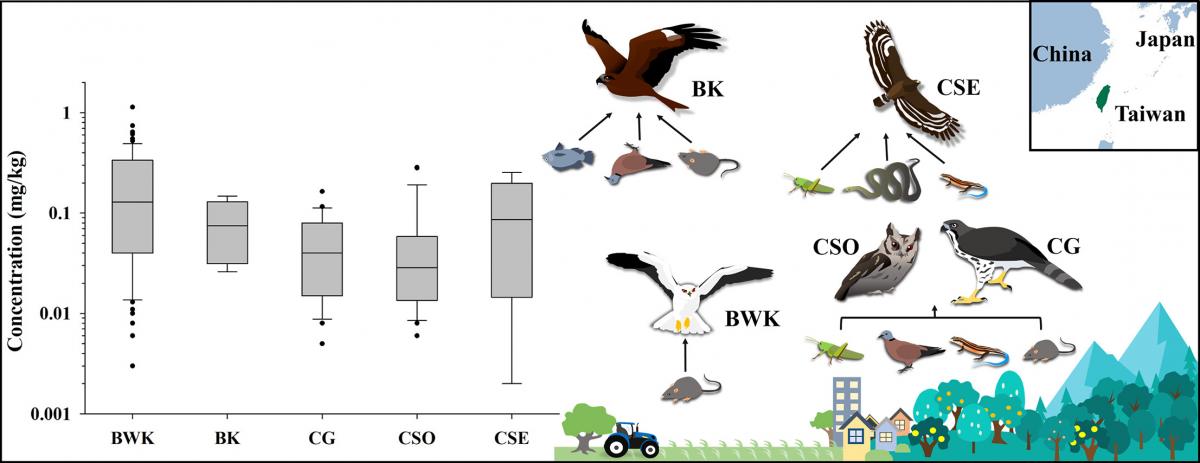Abstract
Anticoagulant rodenticides (ARs) are known to cause extensive secondary exposure in top predators in Europe and North America, but there remains a paucity of data in Asia. In this study, we collected 221 liver samples of 21 raptor species in Taiwan between 2010 and 2018. Most samples were from rescue organizations, but some free-ranging individuals were from bird-strike prevention measures in airports. ARs were detected in 10 species and more than half of the total samples. Common rodent-eating Black-winged Kite (Elanus caeruleus) had the highest prevalence (89.2%) and highest sum concentration (0.211 ± 0.219 mg/kg). The scavenging Black Kite (Milvus migrans) and snake-eating Crested Serpent-eagle (Spilornis cheela) had the second highest prevalence or sum concentration, respectively. Seven AR compounds were detected, of which brodifacoum was the most common and had the highest average concentration, followed by flocoumafen and bromadiolone. The frequency of occurrence in the three most numerous species (Black-winged Kite, Crested Goshawk [Accipiter trivirgatus], and Collared Scops-owl [Otus lettia]) was significantly higher in autumn than summer, which was consistent with the timing of the Taiwanese government's supply of free ARs to farmers. Regional differences in the detection of individual compounds also tended to reflect differences in human population density and use patterns (in agriculture or urban environments). Free-ranging Black-winged Kites had similar high AR prevalence and concentrations as injured birds sampled from rescue organizations. In contrast, clinical poisoning was confirmed in Black Kites with sum concentrations as low as 0.026 mg/kg. Further study of interspecific differences in AR sensitivity and potential population effects are needed. In addition, continued monitoring remains important since the Taiwanese government has modified their farmland rodent control policy to gradually reduce free AR supplies since 2015.
Keywords
Secondary poisoning, Rodent control, Predators, Exposure, SGAR

https://doi.org/10.1016/j.scitotenv.2019.07.076 (Anyone clicking on this link before September 13, 2019 will be taken directly to the final version on ScienceDirect, which they are welcome to read or download.)
-------------------------------------------------
#最新研究證實 台灣猛禽體內普遍驗出老鼠藥!!
自從2014年,屏科大野保所鳥類生態研究室首度證實,有瀕危的黑鳶因老鼠藥中毒死亡,老鼠藥對台灣猛禽的危害才開始受到重視。2015年起由農藥主管機關防檢局邀集多個單位,展開大規模的台灣猛禽體內老鼠藥殘留調查,總計檢驗21種猛禽、全台各地200多件肝臟樣本。結果共有10種猛禽、超過6成的樣本驗出老鼠藥殘留,顯示老鼠藥已經普遍進入台灣生態的食物鏈之中,此研究論文在近日發表於環境科學領域的權威期刊”Science of The Total Environment” (https://doi.org/10.1016/j.scitotenv.2019.07.076)。
#本研究的參與單位
包括屏科大野保所鳥類生態研究室、特生中心野生動物急救站和鳥類研究室、台中市野生動物保育學會、台灣動物路死觀察網(路殺社)等。歷經3年的猛禽樣本收集,樣本主要來自救傷但不治死亡的猛禽,另有部分來自路殺採集或是機場的鳥擊防治措施。猛禽死後經解剖取出肝臟,送往農委會藥物毒物試驗所或是景博科技公司進行14種老鼠藥成分的殘留檢驗。
#研究結果顯示
在平原和低海拔地區常見的5種猛禽中,主食鼠類的黑翅鳶老鼠藥檢出率高達9成,且檢出的平均濃度也最高(211 ppb)。此外,有腐食習性的黑鳶和主食蛇類的大冠鷲,分別是檢出率和平均濃度的第二位,顯示腐食性以及主食蛇類也是老鼠藥中毒的高危險群,並間接證明蛇類可能是老鼠藥在食物鏈中傳遞的重要環節之一。至於在鄉村和都會區很常見的鳳頭蒼鷹和領角鴞,牠們食性廣泛,並非以鼠類為主食,但老鼠藥的檢出率也都超過5成。
#在一年之中
猛禽體內的老鼠藥檢出率和濃度都在秋冬季最高,這很可能跟台灣每年在秋季舉辦滅鼠週有關。農地滅鼠週發放的老鼠藥成分以可滅鼠和伏滅鼠為主,而這兩種也是最常在猛禽體內被驗出的成分。另一種常見成分撲滅鼠,則大多登記為環境用藥,因此不只是農業用藥,居家使用的環境用藥同樣會進入食物鏈之中。台灣自1980年之後核准的老鼠藥幾乎都是第二代,不僅毒性比第一代更強,即使動物沒有吃到致死劑量,在體內要自然代謝的時間長達200天以上,因此相當容易在食物鏈中傳遞和累積。本研究發現有許多猛禽體內驗出不只1種老鼠藥成分,最多的一隻鳳頭蒼鷹體內有高達6種老鼠藥,代表反覆吃進帶有不同老鼠藥的老鼠。
#慢性毒殺
台灣核准的老鼠藥都是抗凝血劑,中毒的動物會逐漸內出血,約5-7天才會死亡。因為是慢性毒,因此中毒的動物屍體其實不易發現,不像劇毒農藥(如加保扶)中毒的鳥類會成群暴斃在毒餌週邊。因為這樣的特性,導致中毒的老鼠仍會四處移動而被天敵捕食,毒害的影響層面比劇毒農藥更廣卻不易察覺。猛禽老鼠藥中毒的臨床症狀包括口腔出血、皮下血腫和貧血等,但光從外觀其實不容易診斷,且中毒的個體往往因為虛弱、行動遲緩而發生意外(如路殺),因而死因被誤判,不會想到背後是老鼠藥惹禍。在老鼠藥檢出率如此高的情況下,當救傷中心收到一隻傷病猛禽,不論傷病原因為何,我們建議都要懷疑是否有中毒的可能性。
#究竟多少的老鼠藥劑量足以致死
這個問題並不容易回答。以國外研究較多的倉鴞為例,出現中毒症狀的個體,肝臟殘留的老鼠藥多在100-200 ppb以上,但不同種類的動物對上不同成分的老鼠藥,感受性可能會差異很大。台灣的黑鳶自1980年代以來族群大量消失,目前被認為跟農藥和老鼠藥的毒害有關,本研究中有兩例黑鳶,屍體被發現時無任何外傷,但出現口腔和內臟出血等中毒症狀,經檢驗肝臟中老鼠藥濃度僅26和33 ppb,顯示微量的老鼠藥就可能讓黑鳶死亡。相較之下,黑翅鳶的老鼠藥檢出率和平均濃度都很高,但其族群近數十年來在台灣(以及整個歐亞大陸)都呈現擴張趨勢,是否因為對老鼠藥的耐受性差異,導致不同猛禽的數量出現消長,非常值得後續研究。
#長達40年的全國滅鼠週
老鼠藥對生態的毒害,在歐美已有許多研究證實,也已經開始限制老鼠藥的使用,但本研究卻是全亞洲首次,顯示亞洲國家對於老鼠藥毒害的忽視。台灣的滅鼠週從1980年代以來,舉辦了將近40年,每年免費發放的老鼠藥多達數百甚至上千公噸。滅鼠周的目的是每年一次將野鼠一網打盡,然而鼠類繁殖力強,幾個月後族群即可恢復,甚至已經逐漸產生抗藥性,但直接或間接毒害的野生動物恐怕已不計其數,尤其是鼠類的掠食者(如草鴞和石虎)更可能深受其害。過去我們經常認為,台灣平原淺山野生動物最大的危機是棲地消失和破碎化,但是都忽略了這個難以察覺的毒害威脅。
#該怎麼辦
所幸防檢局已經開始正視這個問題,在2015年宣布停辦全國農地滅鼠週,減少免費老鼠藥的發放和濫用,然而由環保署主導的居家滅鼠周每年仍持續在辦理,各式各樣的二代鼠藥也可以在商店輕易買到,幾乎沒有任何管制。我們建議未來政府應鼓勵以環境整理、捕鼠器具和生物防治等方式來控制鼠害,並逐步加強對老鼠藥的管制(例如加註警語、提高售價、限制販售管道和購買身分等),以降低農民和民眾對化學藥劑的依賴,讓台灣的野生動物可免於毒害威脅,恢復正常的生態功能。
猛禽中毒照片過於血腥,請點入部落格觀看
延伸閱讀:
基於科學而非感性 滅鼠週40年走入歷史 防檢局長細說由來(2018/10)
黑鳶禍不單行! 首次確認台灣的猛禽體內有老鼠藥殘留(2014/11)